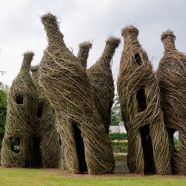
Sortie de Cave (2008) Jardin des Arts, Chateaubourg, France. Photo: Charles Crie
Share This
Print This
Email This
Portfolio: Sculpture
- Summer Palace (2009) Morris Arboretum of the University of Pennsylvania, Philadelphia, PA. Photo: Rob Cardillo
- Running in Circles (1996) TICKON Sculpture Park, Langeland, Denmark. Photo: Hatten 18
- Traveling Companions (2013) Deokpyeong Ecoland, Seoul. Korea. Photo: Solku Choi
- Na Hale ‘Eo Waiawi (2003) Contemporary Art Museum, Honolulu, HI. Photo: Paul Kodama
- Na Hale ‘Eo Waiawi (2003) Contemporary Art Museum, Honolulu, HI. Photo: Paul Kodama
- Out of the Box (2009) North Carolina Museum of Art, Raleigh, NC. Photo courtesy of NCMA
- Out of the Box (2009) North Carolina Museum of Art, Raleigh, NC. Photo courtesy of NCMA
- Pomp and Circumstance (2011) Oregon State University, Corvallis, OR. Photo Credit: Frank Miller
- Pomp and Circumstance (2011) Oregon State University, Corvallis, OR. Photo Credit: Dennis Albert
- Just Around the Corner (2003) New Harmony Gallery, IN. Photo: Doyle Dean
- Just Around the Corner (2003) New Harmony Gallery, IN. Photo: Doyle Dean
- Fit For A Queen (2014) Ville de Nantes, France. Photo: Sapristi-Emmanuelle Tran-le
- Boogie Woogie (2014) Hermann Park, Houston, TX. Photo: Frank Konhouse
- Boogie Woogie (2014) Hermann Park, Houston, TX. Photo: Jared Kudabeck
- Sortie de Cave (2008) Jardin des Arts, Chateaubourg, France. Photo: Charles Crie
- Double or Nothing (2011) Washington University, St. Louis, MO. Photo: Chandler Curlee
I seem to be rooted like a back tooth in twenty acres just west of Chapel Hill, North Carolina. Initially, I burrowed into this land to build a log house, but, in the midst of that effort, I found an approach to the natural world that has remained central to the art life that has consumed me. As I considered shelter, I explored my atavistic tendencies and scoured the nearby woods for interesting building material. Even then, I was dedicated to structures that had reciprocity with their surroundings and seemed to belong to the forest nearby. The last thirty years have proved that, although I had only one house in me, I also magically contained hundreds of building-size sculptures.
Despite returning to the University of North Carolina a few years later to delve into the formal aspects of art, it was the lessons learned while problem-solving the issues of personal shelter that proved the most useful in conceiving sculptures that could be woven through trees and flow over buildings. It was the realization that the saplings crowded along my driveway, when cut and piled together, had an infuriating tendency to entangle with each other, but even more, that these branches could be seen as lines with which to draw and could be configured into large scale patterns, reminiscent of the hatch marks and the gestural lines of the winter landscape.
I always joke that the line between trash and treasure is very thin when using saplings and I think it is ironic that a simple approach honed in my North Carolina yard could generate a string of sculptures throughout the United States, Europe and as far away as Korea. My approach has been to find a source for saplings somewhere close to the building site. It might be a ditch bank, a power line easement, or land waiting for development. It might be willows in California, sweet gum in South Carolina, or Chinese elm along a river in Kansas. Secondly, I wanted my saplings sculptures to nestle in their surrounds and seem “right” to the viewers who pass by. The key is to construct the work on site and make subtle adjustments to scale as the work proceeds. Special attention has to be given to the seam where the sculpture meets the real world and that edge requires truckloads of saplings to make it look credible. The best outcome requires throwing away the plans and responding to the material, with a vigilance towards crafting a shape that will compel and stir the viewer’s imagination. And despite the echo of wilderness in each sapling, I often refer to them as “tapered lines with which to draw” and coach my volunteers in the techniques of my rough-hewn drawing style. Finally, my work has remained temporary. I often quip, “You get one good year and one pretty good year.” The works are vulnerable to the risk of weather and the wear and tear of use. As with the beauty of a spring flowerbed, the fleeting lifespan of these objects adds urgency on one hand and a bittersweet pleasure on the other.
Perhaps it’s inherent Southern hospitality, but I maintain an open building site wherever I work and invite passersby “up on the porch for a spell.” Whether at the Brooklyn Botanical Gardens, an ancient Shinto shrine in Japan, or on the steps of Federation Square in Melbourne, Australia, I listen to stories about birds, childhood play, and visions of simple shelter. It’s clear that a good stick remains an imaginative object for us well into adulthood and that the world is full of closet stick gatherers. It’s not surprising then that my workforce grew itself and that just about everyone who calls “hello” wants to be part of the crew.
During the past thirty years, I have averaged ten major sapling installations per year, each requiring three weeks from start to finish. Nevertheless, I always look forward to getting back to Chapel Hill and spending time in the woods around my house. Sometimes in a lull, I conjure up the picnic table where I built my first sapling sculpture from those red maples near the creek. That day was magical; it was a portal ajar—a narrow hallway between my front yard and the bigger world of ideas.







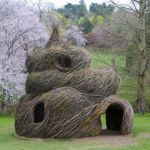
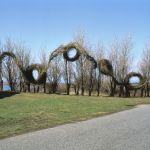
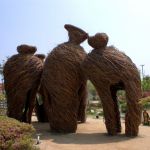
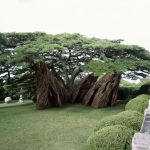
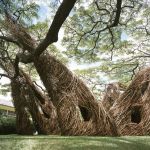
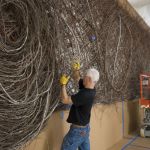
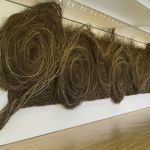
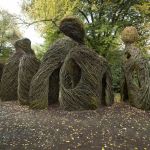
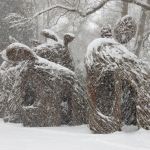
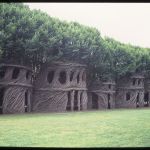
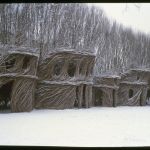
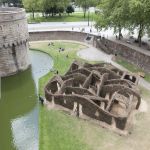
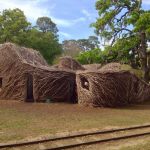

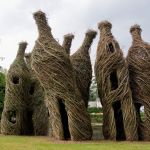
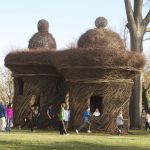
Who would’ve known? The sculptures are a lesson in themselves about the land, the nature that is available in ways unseen to too many of us, to become art and a use for human creatures. It makes me think of how remotely I have distanced myself from nature, from my particular land, and what is right in front of me.